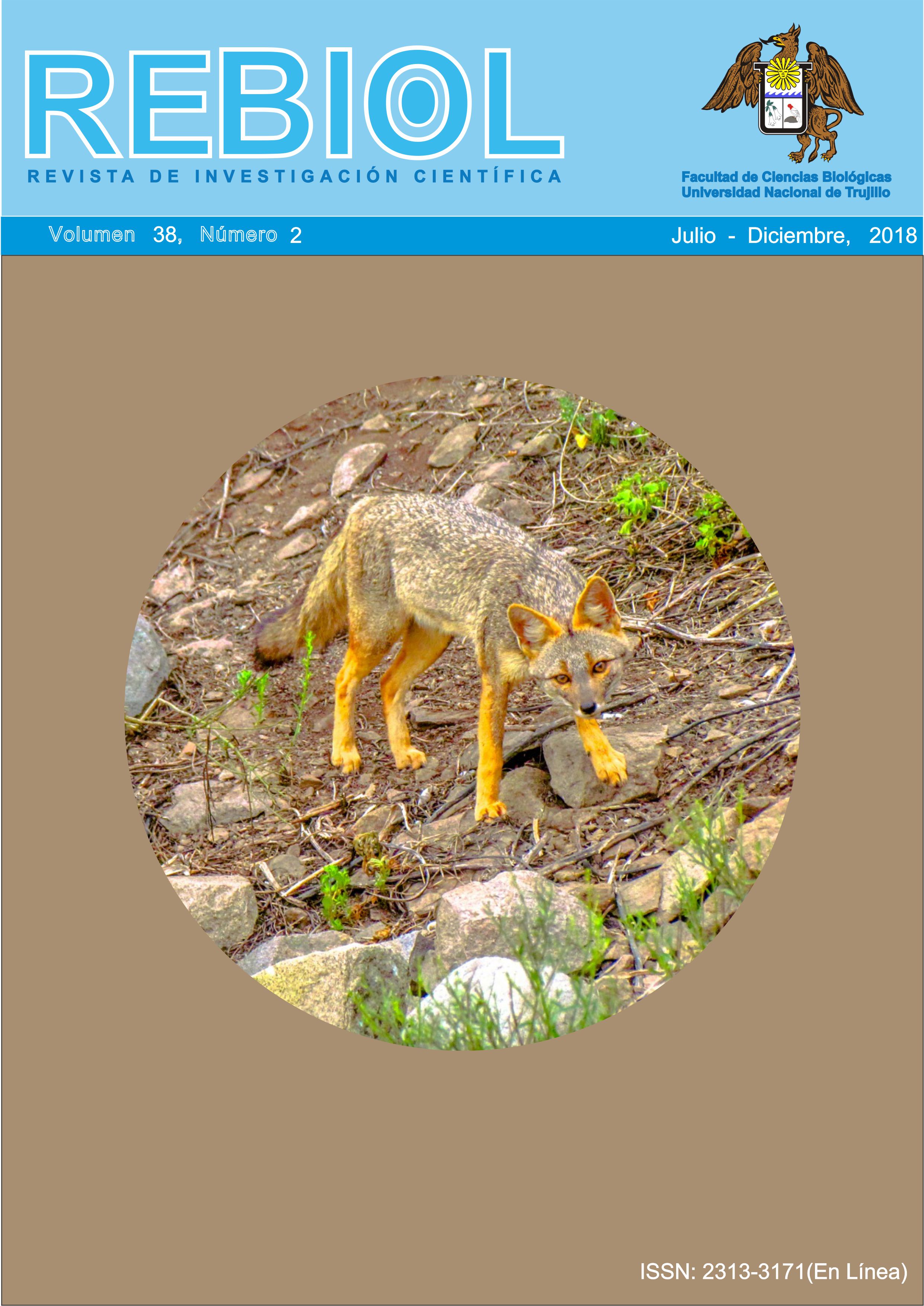Efecto del brebaje ayahuasca sobre la temperatura corporal de rattus norvegicus variedad albina
Resumen
La ayahuasca es un brebaje a base de hierbas, preparado ancestralmente con fines medicinales y religiosos, en la actualidad, se emplea en terapias de curación de adicciones a las drogas y se investiga la posibilidad de que tenga propiedades contra algunas enfermedades neurodegenerativas. En este estudio se utilizaron dos plantas que forman parte del brebaje “ayahuasca”, Banisteriopsis caapi que contiene alcaloides β-carbonilos y Psycotria viridis que contiene N.N-dimetiltriptamina (DMT), las cuales fueron mezcladas para preparar un decocto, el cual se administró a 10 animales de experimentación, teniendo a otros 10 como control negativo, el objetivo fue determinar el efecto del brebaje ayahuasca sobre la temperatura corporal de ratas, medida a nivel rectal, la cual se midió cada treinta minutos durante noventa minutos. La temperatura rectal varió en los minutos 30 al 60, aumentando de 36,18 a 38,03 °C y de 36,15 a 38,03 °C respectivamente con un p<0,05. Podemos concluir que el brebaje ayahuasca produce cambios en la temperatura corporal de ratas.
Palabras clave: ayahuasca, temperatura rectal, N.N-dimetiltriptamina, DMT, harmalina.
Citas
McKenna D, Towers G, Abbot F. Monoamine oxidase inhibitors in south american hallucinogenic plants: Tryptamine and b-carboline constituents of Ayahuasca, Journal of Ethnopharmacology. 1984; 10(2):195-223
Ruiz L, Ruiz L, Maco M, Cobos M., Gutierrez-Choquevilca A, Roumy V. Plants used by native Amazonian groups from the Nanay River (Peru) for the treatment of malaria. Journal of Ethnopharmacology. 2011; 133,917–921.
Mabit J, Campos J, Arce J. Consideraciones Acerca del Brebaje Ayahuasca y Perspectivas Terapéuticas. Revista de Neuro-Psiquiatría. 1992; 55(2):1-13.
Sanz-Biset J, Campos-de-la-Cruz J, Epiquién-Rivera M, Cañigueral S. A first survey on the medicinal plants of the Chazuta valley (Peruvian Amazon). Journal of Ethnopharmacology. 2009; 122, 333–362.
Rivier L, Lindgrend J. “Ayahuasca”, the South American hallucinogenic drink: an ethnobotanical and chemical investigation. Economic botanic. 1972; 26(2):101-129.
Halberstadt A, Geyer M. Multiple receptors contribute to the,behavioral effects of indoleamine hallucinogens. Neuropharmacology. 2011; 61(3):364–381.
Callaway J, Brito G, Neves E. Phytochemical Analyses of Banisteriopsis caapi and Psychotria viridis. Journal of Psychoactive Drugs. 2005; 37(2):145-150.
Pino J, Alvis R. Efecto de Brugmansia arborea (L.) Lagerheim (Solanacea) en el sistema reproductor masculino de ratón. Revista Peruana de Biología. 2009; 15(2):125-127.
Mattioli L, Bracci A, Titomanlio F, Perfumi M, De Feo V. Effects of Brugmansia arborea extract and its secondary metabolites on morphine tolerance and dependence in mice. Evidence-based Complementary and Alternative Medicine. 2012; 2012(1):1-10.
Dos Santos R, Hallak J. Effects of the Natural β-Carboline Alkaloid Harmine, a Main Constituent of Ayahuasca, in Memory and in the Hippocampus: A Systematic Literature Review of Preclinical Studies. Journal of Psychoactive Drugs. 2016; 49(1): 1-10.
Randall D, Burggren W, French K. Eckert Fisiología Animal Mecanismos y Adaptaciones. 4a ed. Madrid: McGraw-Hill Interamericana de España; 1998.
Beyer J, Drummer O, Maurer H. Analysis of toxic alkaloids in body samples. Forensic Science International. 2009; 185(1-3):1–9.
Burillo-Putze G, López E, Climent B, Munné P, Nogue S, Pinillos M, Hoffman R. Drogas emergentes (III): plantas y hongos alucinógenos. Anales del Sistema Sanitario de Navarra. 2013; 36(3): 505-518.
Su T, Hayashi T, Vaupel D. When the Endogenous Hallucinogenic Trace Amine N,N-Dimethyltryptamine Meets the Sigma-1 Receptor. Science Signaling. 2008; 2(61): 1-7.
Chu U, Vorperian S, Satyshur K, Eickstaedt K, Cozzi N, Mavlyutov T, Hajipour A, Ruoho A. Noncompetitive Inhibition of Indolethylamine-N-methyltransferase by N,N-Dimethyltryptamine and N,N-Dimethylaminopropyltryptamine. Biochemistry. 2014; 58(18):2956–2965.
Timmermann C. Neurociencias y aplicaciones psicoterapéuticas en el renacimiento de la investigación con psicodélicos. Revista Chilena de Neuro-Psiquiatría. 2014; 52(2):93-102.
Alonso J, Romero S, Mañanas M, Riba J. Serotonergic Psychedelics Temporarily Modify Information Transfer in Humans. International Journal of Neuropsychopharmacology. 2015; 18(8):1-9.
Jiang X, Shen H, Yu A. Potentiation of 5-methoxy-N,N-dimethyltryptamine-induced hyperthermia by harmaline and the involvement of activation of 5-HT1A and 5-HT2A receptors. Neuropharmacology. 2015; 89:342–351.
Shen H, Ling-Jiang X, Winter J, Yu A. Psychedelic 5-Methoxy-N,N-dimethyltryptamine: Metabolism, Pharmacokinetics, Drug Interactions, and Pharmacological Actions. Current Drug Metabolism. 2010; 11(8):659–666.
Winter J, Amorosia D, Rice K, Cheng K, Yu A. Stimulus control by 5methoxy-N,N-dimethyltryptamine in wildtype and CYP2D6-humanized mice. Pharmacology and Biochemistry Behavior. 2011; 99(3):311–315.
Callaway J, McKenna D, Grob C, Brito G, Raymon L, Poland R, Andrade E, Andrade E, Mash DPharmacokinetics of Hoasca alkaloids in healthy humans. Journal of Ethnopharmacology. 1999; 65:243–256.
Descargas
Publicado
Cómo citar
Número
Sección
Licencia
Derechos de autor 2019 REBIOL

Esta obra está bajo una licencia internacional Creative Commons Atribución-NoComercial-CompartirIgual 4.0.
Política propuesta para revistas que ofrecen acceso abierto
- Los autores/as conservarán sus derechos de autor y garantizarán a la revista el derecho de primera publicación de su obra, el cual estará simultáneamente sujeto a la «Licencia de reconocimiento» de Creative Commons que permite a terceros compartir la obra siempre que se indique su autor y su primera publicación en esta revista.
- Los autores podrán adoptar otros acuerdos de licencia no exclusiva de distribución de la versión de la obra publicada (por ejemplo, depositarla en un repositorio institucional o publicarla en un libro) siempre que se indique la publicación inicial en esta revista.
- Los autores tienen el derecho a hacer una posterior publicación de su trabajo, de utilizar el artículo o cualquier parte de aquel (por ejemplo: una compilación de sus trabajos, notas para conferencias, tesis, o para un libro), siempre que indiquen su publicación inicial en la revista REBIOL (autores del trabajo, revista, volumen, número y fecha).







